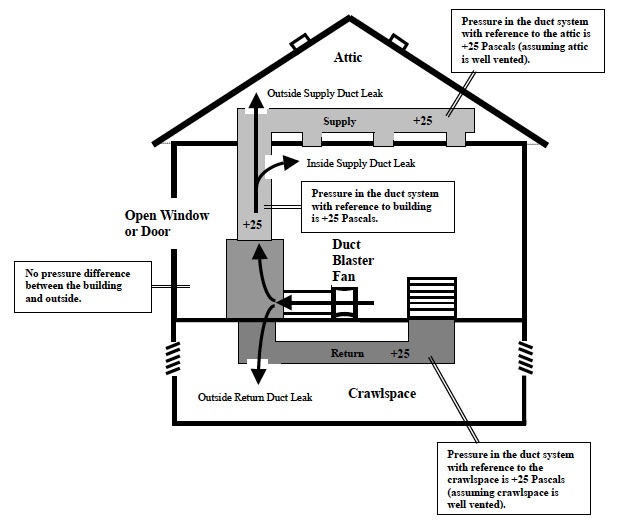In the previous page on the basic duct leakage testing procedure, we said that you pressurize the duct system and measure the airflow through the fan. To find the total duct leakage, that’s basically all you do. The only other thing you need to make sure you do is keep the spaces where the ducts are at the same pressure as the outdoors, as much as you can anyway.

The diagram above (taken from the Energy Conservatory‘s Duct Blaster Manual) shows the setup for the total leakage test. The Duct Blaster fan blows air into the duct system. Here it’s shown attached at the air handler, though most often it’s attached to a return vent. The crawl space and attic are both vented and thus close to the same pressure as outdoors. The house is shown having an open door or window to equalize pressures with the outdoors.
When the Duct Blaster is turned on and the sytem brought up to 25 Pascals of pressure, air will leak out wherever there’s a hole in the duct system. Some of that leakage, as we said before, is benign (to the conditioned space), and some is malignant (to the unconditioned spaces).
To find out how to eliminate the leakage to the conditioned spaces and measure only the leakage that the homeowners pay for, read on. (Or go back to the main duct leakage page.)
The IntroVerter Heat Pump: Quietly Efficient and Hoping You Won’t Notice
You know those heat pumps that seem to be doing their best impression of a jet engine every time they…
Allison was hired to design and teach a training class to introduce our employees to HERS ratings and general building science. He took a difficult and complex subject and condensed it into an enlightening and entertaining two hour class that made quite an impression on our staff. Allison is an expert in his field, a very effective and accessible trainer, and an all-around great guy. We hope to partner with him on future projects.

![Meet The New Introverter Heat Pump, Comfortably Keeping Its Distance While Silently Keeping You Comfortable. [Image By ChatGPT]](https://www.energyvanguard.com/wp-content/uploads/2025/03/introverter-heat-pump-introvert-at-a-party-325x325.png)